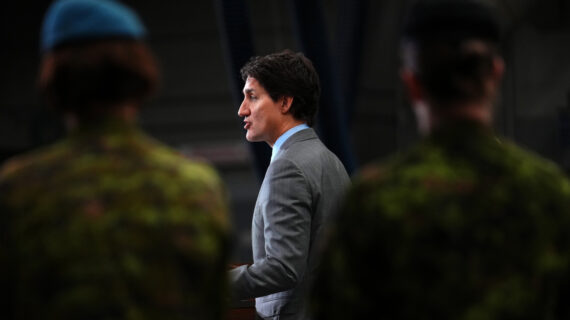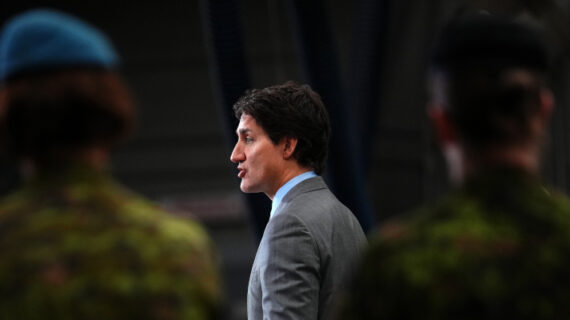The Hub is delighted to announce The Business of Government, a special series hosted by award-winning journalist and best-selling author Amanda Lang about how government works and, more importantly, why it sometimes doesn’t work. In this five-part series, Lang conducts in-depth interviews with experts and former policymakers and puts it all in perspective for the average Canadian. Listen to the accompanying interview with Livio Di Matteo on your favourite podcast app or at The Hub.
When it comes to the size of government, it can quickly feel like a political question. Government that plays a larger role in the lives of citizens, or “big government,” is deemed to lean Left, while a more limited, or smaller government is the domain of the Right.
In the end, the size of government, as measured by the roles it will play, from services delivered to regulatory burden, will and should be a political question. But even in the context of the size voters want, big or small, we can still ask about effectiveness. Because like any other organization, there may be an optimal size for government for maximum efficiency and output.
So how are we doing, Canada?
Livio Di Matteo is an economist in northern Ontario who has studied the size of government, including analysis of the work of many economists looking at the issue. Turns out that to optimize growth, there is a perfect size of government relative to the economy. Government spending does affect economic growth, so that too little of it can stunt a country’s potential. Just enough maximizes economic activity, while too much acts as a drag on output.
“The general rule of thumb is there are diminishing returns beyond a certain point to any activity, even government,” Di Matteo says.
So, what is the sweet spot for government spending? A comparison of industrialized nations over the long term suggests that 26 percent of GDP is the growth-maximizing size of government. Spending above that level will act as a drag on growth potential. The difference can be growing at 3 percent versus landing at 2 percent.
“People may say, ‘Well what’s 1 percent,’” Di Matteo says. “But because of the power of compounding over time, over 30 or 40 years, that difference can mean per capita incomes that are 20 to 30 percent lower.”
In Canada government spending has ranged from 34 percent to a high-water mark of 53 percent in the 1990s and “we’ve never really been in the range that maximizes economic growth,” Di Matteo says.
Size of government here is not just the literal size—in Canada’s case a recent surge to 357,247 federal government employees—but spending on goods and services as well, or program spending. Different measures of size of government also calculate control of the economy through regulation and taxation, but it’s harder to make a country-by-country comparison since each one will be so different.
Over time government in Canada has waxed and waned. From a historic low of 5 to 10 percent in pre-industrial times, to the higher levels of the past decades. A period of shrinking governments from the late 1990s was interrupted by three surges in spending. The first was the terrorist attacks of 9/11 with a host of new security measures. The second was fiscal support after the great financial crisis around 2008, and the last being the massive increase in spending during the COVID-19 pandemic. Estimates of the size of government now are about 45 percent of GDP. Part of the problem with a government that exceeds its growth-fostering range is that it requires higher taxes to fund. Or in the case of periods of surge spending, deficit funding.
Some government spending, on things like infrastructure or education, is naturally growth-enhancing, because it creates a better foundation for the private sector. And there are a host of things that governments do, like protecting economic freedom, fostering low corruption, and promoting robust rule of law, which are less quantifiable yet are essential to a well-functioning private sector.

“Governments obviously do other things, but there is a trade-off involved. And the question is, what is the value of all these other things that we are doing? And, you know, what can you do to bring yourself closer to that optimum to maximize growth?” Di Matteo says.
It almost seems as though policymakers in Canada shape spending based on outdated views of our economy.
“We always like to spend based on the growth we had, during the great golden age from 1945 to the mid-1970s,” Di Matteo says. Then real economic growth was 4 to 6 percent. “We often justified it by saying if we send this the economy will grow,” but the reality is growth in Canada runs closer to 2 percent these days, “if that.”
Di Matteo doesn’t want to be drawn into making policy prescriptions about the kinds of spending government should do, saying those are political questions best left to elected representatives. But he will offer up the view that not all spending is created equal: health and education, for instance, are investments government can make in the human capital of a country that could be considered a worthy investment.
But even there, it’s important to ask if the spending is being done wisely. Canada has a decent health-care system, by most global measures. But do we get good results for the spending on it, at about 11 percent of GDP?
Here Di Matteo is more circumspect. “We always compare ourselves to the United States, which spends 17 to 20 percent of its GDP on health, and yet its outcomes in many respects, things like mortality, longevity, infant mortality, etc, are actually even worse than ours.” But before declaring victory, he would point to countries like Germany or the Netherlands, where outcomes are better, and the spending is less. “And so, the question is, how do we get more value for money?”
And there are other questions about government that go beyond sheer size, about how effective they are. “Why is it when the Dutch have a public-sector project, say they build a bridge, they do it in a few months? And it takes us a few years? What are we doing wrong or not as well, that we could improve upon?”
Government subsidies for business is one area that economists like Di Matteo point to as places of questionable return.
“How much you spend is important, but what you spend it on is also important. And sometimes it’s not even so much the amount of spending, but are you getting value for money for what you’re spending.”
In other words, size does matter, but it’s also what you do with it that counts.




